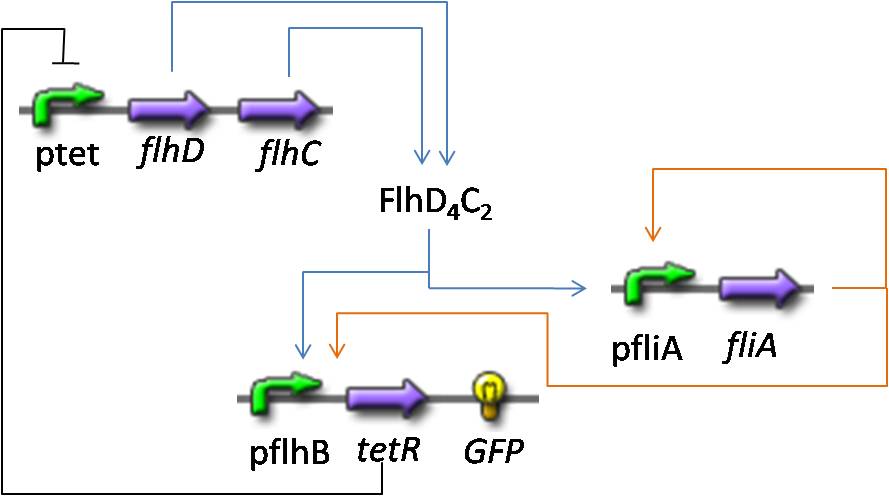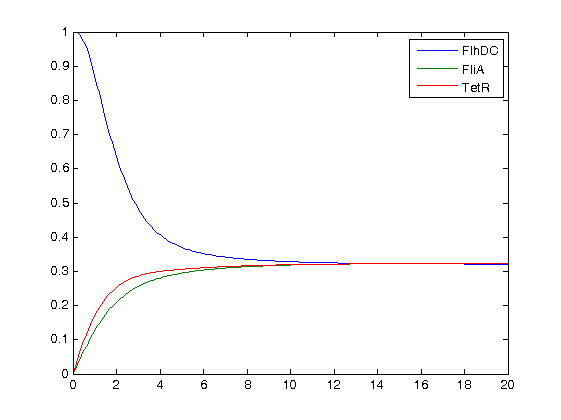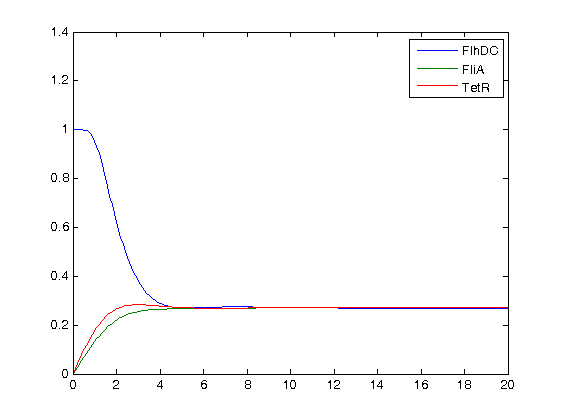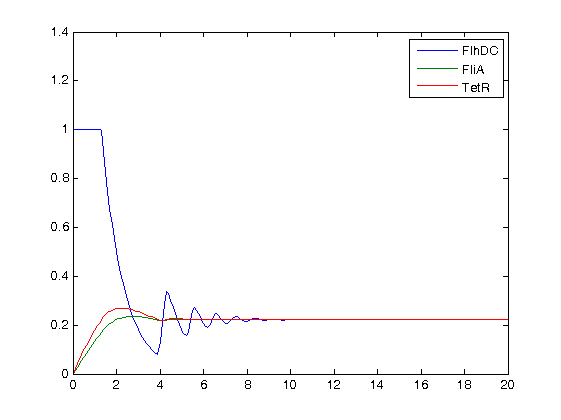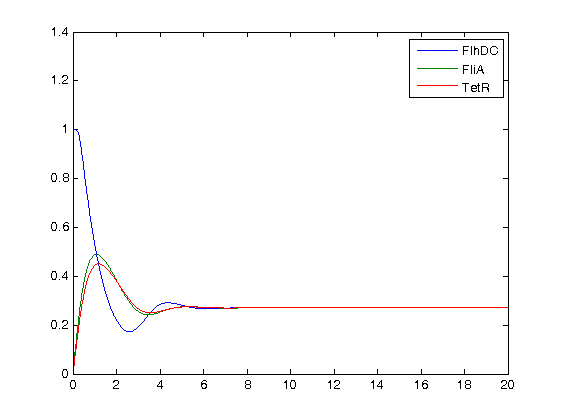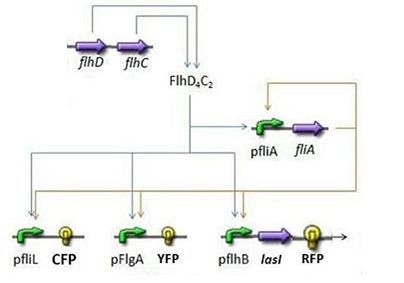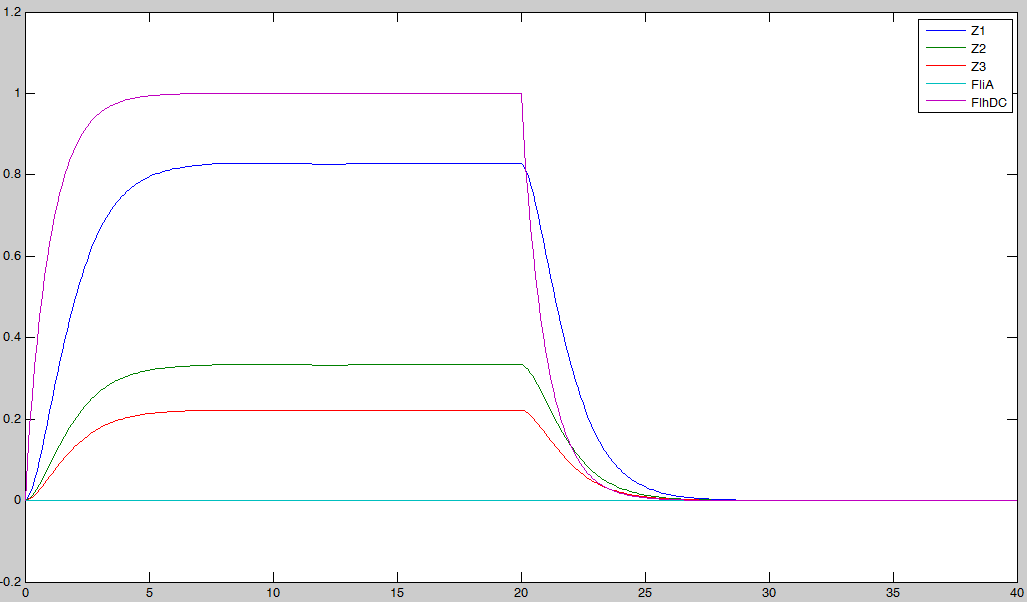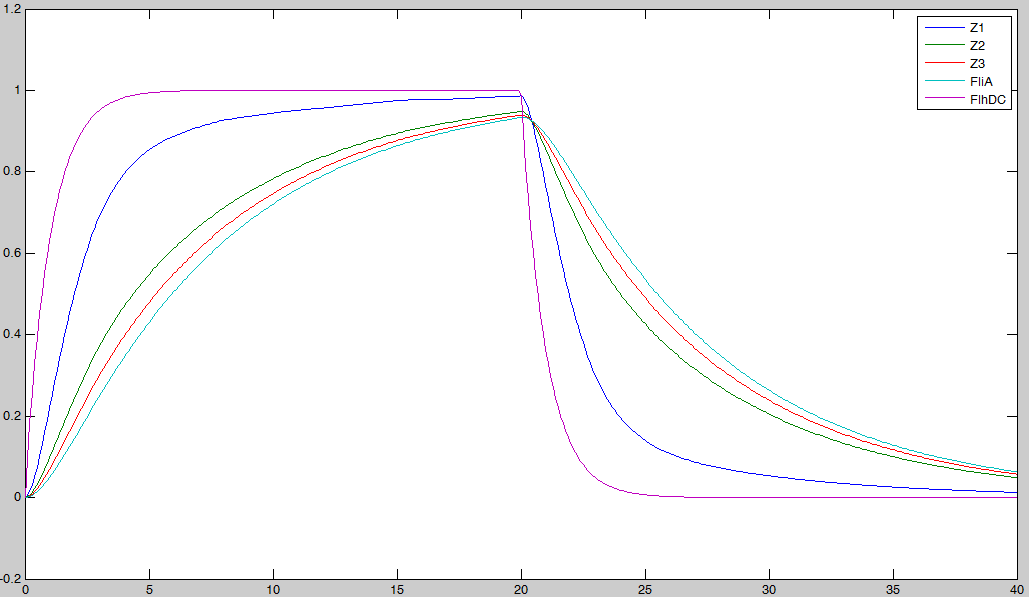Team:Paris/Modeling/BOB/Simulations
From 2008.igem.org
(→Oscillations) |
(→Oscillations) |
||
| Line 45: | Line 45: | ||
</center> | </center> | ||
| - | * | + | * We decided to run simulations with different values of the parameters of the Hill function. Here are plot examples with pFlhB at first : |
[[Image:essai_simul_2.jpg|400px|left|thumb|n=2 : no oscillations to be seen]][[Image:essai_simul_n=5_2.jpg|400px|right|thumb|n=5 : some oscillations at the begining...]][[Image:essai_simul_n=5_zoom.jpg|400px|left|thumb| and some subdued oscillations when we zoom!]][[Image:essai_simul_n=300_2.jpg|400px|right|thumb|with a drastic (though non-biological) increase of n : n=300]] | [[Image:essai_simul_2.jpg|400px|left|thumb|n=2 : no oscillations to be seen]][[Image:essai_simul_n=5_2.jpg|400px|right|thumb|n=5 : some oscillations at the begining...]][[Image:essai_simul_n=5_zoom.jpg|400px|left|thumb| and some subdued oscillations when we zoom!]][[Image:essai_simul_n=300_2.jpg|400px|right|thumb|with a drastic (though non-biological) increase of n : n=300]] | ||
<br><br><br><br><br><br><br><br><br><br><br><br><br><br><br><br><br><br><br> | <br><br><br><br><br><br><br><br><br><br><br><br><br><br><br><br><br><br><br> | ||
| Line 53: | Line 53: | ||
<br><br><br><br><br><br><br><br><br><br><br><br><br><br><br><br><br><br><br> | <br><br><br><br><br><br><br><br><br><br><br><br><br><br><br><br><br><br><br> | ||
| - | * What consequences | + | * What are the consequences of these observations? |
| - | + | ** First of all, we may see that it is hard to get stable oscillations with this short system. However, depending on the time scale, and the concentration scale (since in our models, every concentration is normalized), it is possible to sustain oscillations for some period. We may see on the zoom of the plot where we considered pFlgB and n=5 that there are non-obvious but enduring oscillations of FlhDC. | |
| + | ** Then, we have understood that the Hill coefficient was in that case the key parameter. In fact, while trying to change other parameters, we did not improve the results. Yet, this is a key element as far as the wet-lab is concerned. | ||
| + | ** Furthermore, one may see that FlhDC is the source oscillator, and that the other two are following. Then, we need to put the promoter which reaction to FhlhDC is the strongest. Thus the choice of pFliL rather than pFlhB. The simulations above confirm this train of thought. Again, this is a key element to give to our wet-lab! | ||
| + | ** To conclude, these results that are seemingly "bad news" still give us information. Indeed, we now know what gene to chose and what we can do to try to improve it. | ||
| + | ** | ||
| + | ** This can be confirmed by the mathematical study of the system A FAIRZE§ | ||
| + | ** | ||
ccl : | ccl : | ||
no oscill stable, mais un peu qd mme, donc a voir sur les constantes de temps | no oscill stable, mais un peu qd mme, donc a voir sur les constantes de temps | ||
Revision as of 15:09, 2 September 2008
|
(Under Construction) Simulations and Mathematical analysis Oscillations
ccl : no oscill stable, mais un peu qd mme, donc a voir sur les constantes de temps mais intéressant: il faut choisir le premier, celui qui suit de plus pres flhDC!!! pour avoir le plus de chance d'avoir des oscillations, puisque c'est le terme de HIll qui fait osciller puis a voir avec le systeme bio perturbé, cad que c'est pas dramatique puis matrice puis biocham a introduire FIFO
Here is the system we implementated using Matlab (see the corresponding codes) and the corresponding equations (for more detailed information see our establishment of the model). where CFP, YFP, and RFP will be denoted below as respectively Z1,Z2 and Z3.
In fact we assumed that this behavior for FlhDC was acceptable regarding its estimated behavior in the whole system.
We may see that there is a LIFO behavior rather than the FIFO we expect...
Synchronisation
|
||||||||||||||||||
 "
"

